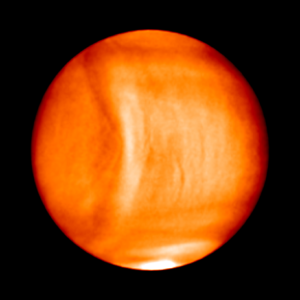
Japanese scientists have discovered a huge wave like feature in the Venus’ cloud region, and according to these scientists, this feature appears to be fixed to the slowly rotating planet, while clouds around it whiz by at about 100 meters per second.
Venus, the “planet of love”, is almost the same size as Earth and orbits closer to the sun. Many astronomers, in earlier centuries used to believe that Venus similar to Earth, has plants and thick vegetation under its clouds and might be supporting life. However, we now know that the environment of Venus is more hellish than romantic. It is a lifeless planet, with hottest planetary surface (447°C) in our solar system, and a thick atmosphere which harbors clouds of sulfuric acid. It rotation speed is slow, and the planet is characterized by hurricane force winds near the poles.
Japanese spacecraft Akatsuki was launched on May 20, 2010 to study the activity and structure of the Venus atmosphere. The spacecraft entered the orbit of the planet in 2015, and has been examining the planet since then. Japanese scientists now report finding a bow-shaped structure extending about 10,000 km through the Venus’ cloud tops. The structure was actually discovered by imaging instruments onboard Akatsuki. This strange feature was observed when imaging cameras looked in the ultraviolet and infrared parts of the electromagnetic spectrum. According to scientists, the wave was observed for a few days, before it suddenly disappeared.
Makoto Taguchi from Rikkyo University in Tokyo and Atsushi Yamazaki from the Japan Aerospace Exploration Agency (Jaxa) found that this bright wave was fixed over Aphrodite Terra—a mountainous region on Venus surface. Moreover, this wave was hotter than neighboring parts of the atmosphere.
The researchers propose that the feature has been created as a result of a gravity wave generated as the lower atmosphere on Venus flows over mountains on planet’s surface, and then propagates upwards through Venus’ thick atmosphere. Gravity waves are formed when a fluid – such as a plasma or liquid – gets displaced from a position of equilibrium.
“If you have a stream and it’s flowing over a rock, you get the gravity waves propagating upwards through the water. At the surface of the stream, you will see it as changes in height.” Dr Colin Wilson told the BBC. Dr Colin is a planetary scientist from the University of Oxford and was not involved in the study.
“What’s happening here is slightly different, because we’re seeing it in cloud top temperatures. But the air particles are moving up and down, very much as the water particles are moving up and down.”
The Japanese scientists in their study write: “The present study shows direct evidence of the existence of stationary gravity waves, and it further shows that such stationary gravity waves can have a very large scale – perhaps the greatest ever observed in the Solar System.”
The detailed findings of the study have been published in Nature Geoscience.

